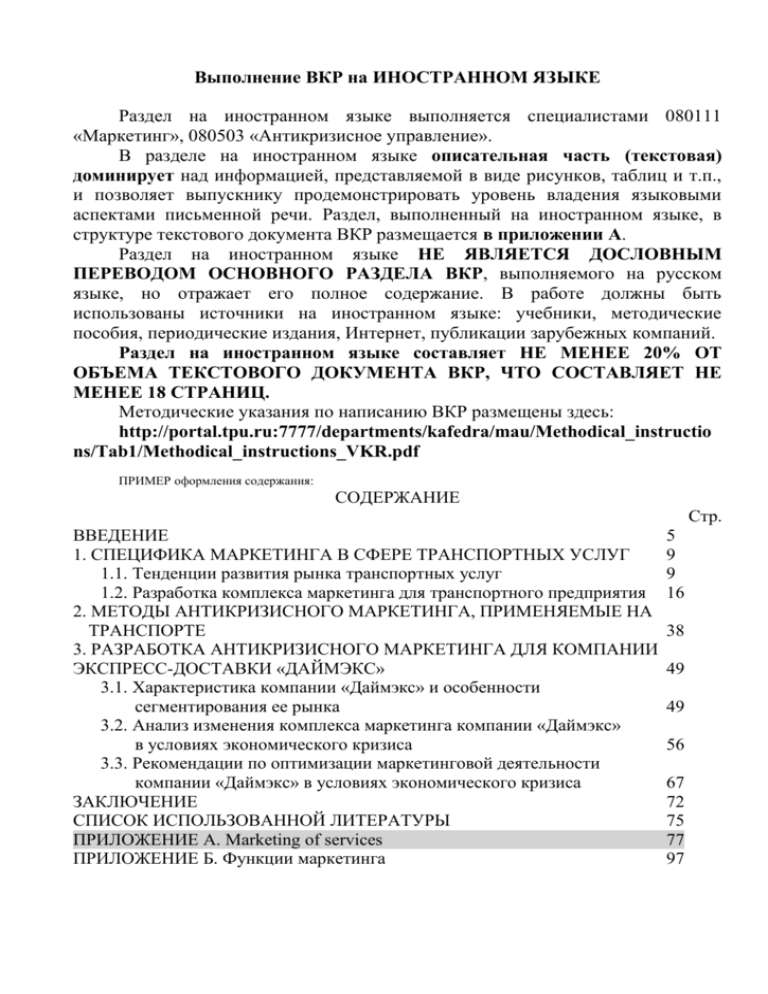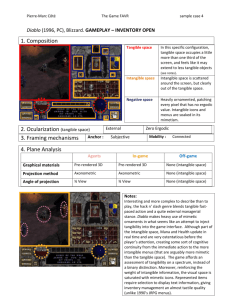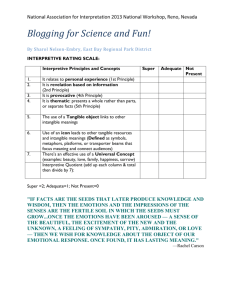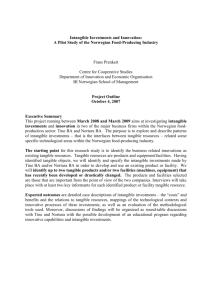Раздел на иностранном языке составляет НЕ МЕНЕЕ 20% ОТ
advertisement

Выполнение ВКР на ИНОСТРАННОМ ЯЗЫКЕ Раздел на иностранном языке выполняется специалистами 080111 «Маркетинг», 080503 «Антикризисное управление». В разделе на иностранном языке описательная часть (текстовая) доминирует над информацией, представляемой в виде рисунков, таблиц и т.п., и позволяет выпускнику продемонстрировать уровень владения языковыми аспектами письменной речи. Раздел, выполненный на иностранном языке, в структуре текстового документа ВКР размещается в приложении А. Раздел на иностранном языке НЕ ЯВЛЯЕТСЯ ДОСЛОВНЫМ ПЕРЕВОДОМ ОСНОВНОГО РАЗДЕЛА ВКР, выполняемого на русском языке, но отражает его полное содержание. В работе должны быть использованы источники на иностранном языке: учебники, методические пособия, периодические издания, Интернет, публикации зарубежных компаний. Раздел на иностранном языке составляет НЕ МЕНЕЕ 20% ОТ ОБЪЕМА ТЕКСТОВОГО ДОКУМЕНТА ВКР, ЧТО СОСТАВЛЯЕТ НЕ МЕНЕЕ 18 СТРАНИЦ. Методические указания по написанию ВКР размещены здесь: http://portal.tpu.ru:7777/departments/kafedra/mau/Methodical_instructio ns/Tab1/Methodical_instructions_VKR.pdf ПРИМЕР оформления содержания: СОДЕРЖАНИЕ Стр. ВВЕДЕНИЕ 1. СПЕЦИФИКА МАРКЕТИНГА В СФЕРЕ ТРАНСПОРТНЫХ УСЛУГ 1.1. Тенденции развития рынка транспортных услуг 1.2. Разработка комплекса маркетинга для транспортного предприятия 2. МЕТОДЫ АНТИКРИЗИСНОГО МАРКЕТИНГА, ПРИМЕНЯЕМЫЕ НА ТРАНСПОРТЕ 3. РАЗРАБОТКА АНТИКРИЗИСНОГО МАРКЕТИНГА ДЛЯ КОМПАНИИ ЭКСПРЕСС-ДОСТАВКИ «ДАЙМЭКС» 3.1. Характеристика компании «Даймэкс» и особенности сегментирования ее рынка 3.2. Анализ изменения комплекса маркетинга компании «Даймэкс» в условиях экономического кризиса 3.3. Рекомендации по оптимизации маркетинговой деятельности компании «Даймэкс» в условиях экономического кризиса ЗАКЛЮЧЕНИЕ СПИСОК ИСПОЛЬЗОВАННОЙ ЛИТЕРАТУРЫ ПРИЛОЖЕНИЕ А. Marketing of services ПРИЛОЖЕНИЕ Б. Функции маркетинга 5 9 9 16 38 49 49 56 67 72 75 77 97 Приложение А FEDERAL EDUCATIONAL AGENCY State Establishment of Higher Education National Research Tomsk Polytechnic University Department: IEF Specialization: Marketing (Antirecession management) MARKETING OF SERVICES Project Work Group: 3640 Student: P.S. Lavreshina (signature) Advisor: T.S. Selevich (signature) Supervised by: E.V. Merkulova (signature) Tomsk – 2010 CONTENTS Annotation 79 Introduction 80 1. Scope of services marketing management 81 2. Unique service features and resulting marketing management issues 84 3. Conceptualizing the marketing mix service 87 4. Services marketing dimensions 90 Conclusion 96 References 75 ANNOTATION The development of the services literature has occurred over the last part of the twentieth century in terms of overall theories and concepts that have been introduced in this work. The main objective of this work is to illustrate the characteristics and core components of services and to discuss influence of the service marketing mix. This work consists of four parts. The first part called scope of services marketing management. In this part are described considerable agreement about the characteristics and core components of services which include intangibility, inseparability, heterogeneity and perishability. The second part called unique service features and resulting marketing management issues. In this part are discussed the differences between goods and services. Then a description of dimensions that from the component parts of conceptual frameworks and models for services marketing is presented. The third part called conceptualizing the marketing mix service. In this part are described underpinning concepts of the service management. It briefly outlines the history and origins of services marketing and management and provides some background discussion explaining the debates that have led to the identification of the now widely accepted characteristics of services. The forth part called unique service features and resulting marketing management issues. In this part analyzed all the dimensions, concepts and frameworks that illustrate widely recognized and universally acceptable service dimensions. Finally, the most frequently used conceptual frameworks are discussed in some depth, encapsulating the chief characteristics of services. INTRODUCTION Services marketing as an academic discipline have developed rapidly in the last twenty years. From humble beginnings as the ‘stepchild’ of goods marketing, services have become established as an area with specific needs and characteristics that deserve, if not demand, consideration. It ahs been suggested that any new discipline firstly needs to establish itself in terms of the old, to show that there is a reason for this existence by at least acknowledging, if not rejecting, what has gone before it. Services are all around us – as consumers we use services every day. The growth in the service economy is widely recognized and increasingly contributes to the economic development of many regions. Although the service sector accounts for most of new job growth in developed countries, the dominance of the service sector is not limited to highly developed nations. Many services such as those in the tourism sector contribute very heavily to developed economies also. By their very nature, services are diverse and therefore have often been difficult to define. However there have been many attempts to describe services and there is an overall recognition of what they are and how they contribute to marketing offerings and the economy. In this work the differences between goods and services will be discussed and lead to description of the characteristics of services impact on the different elements of the service offering. 1. SCOPE OF SERVICES MARKETING MANAGEMENT Most frequently, a service has been described as an act, a process and a performance. For example, activities such as accountancy, banking and hair-dressing can be recognized as being predominantly service based. Also services can be more widely described as economic activities that create ‘added value’ and provide benefits for customers (customers or organizations). Today most products include some element of service. However, a service ‘product’ or a service company can be differentiated from customer service that is provided by all types of companies such as manufacturers and IT companies as well as service companies. Customer service usually entails answering questions, handling complaints, dealing with queries, taking orders, the provision of maintenance and repairs and other after sales services. Although customer service is inherent in services marketing it is carried out as an additional function by many industries. There are many products that depend upon service-based activities to give them a competitive advantage. For example, someone buying a new computer may be attracted to the store where s/he will also receive useful information and guidance from a helpful staff member at the store, a hotline service for installing programs, and other services, in addition to their preferred computer. Recognizing the value of this to potential customers, computer store service managers will aim to offer many additional useful services for customers. This illustrates the value and relevance of understanding and recognizing the importance that service issues have on today’s society. A service business is one where the perceived value of the offering to the buyer is determined more by the service rendered than the product offered. In this way the nature and scope of services pose different challenges for managers in service businesses. Such businesses include those that provide an almost entirely intangible offering, such as legal services, healthcare, and cleaning services and businesses that offer both services and products such as restaurants and retail outlets. The definition and cope of the service concept is wide and can mean any or all of the following: Service as an organization, that is the entire business or not-for-profit structure that resides within the service sector. For example, a restaurant, an insurance company, a charity. Service as a core product, that is, the commercial outputs of a service organization such as a bank account, an insurance policy or a holiday. Service as a product augmentation, that is any peripheral activity designed to enhance the delivery of a core product. For example, provision of a courtesy car, complimentary coffee at the hairdressers. Service as a product support, that is, any product- or customer-oriented activity that takes place after the point of delivery. For example, monitoring activities, a repair service, up-dating facilities. Service as an act that is service as a mode of behavior such as helping out, giving advice. However, from a market or consumer’s point of view the relative importance of different components of the service offering can range vastly from one customer to another. So a service must be considered from the point of view of many types of customers. For example, two people may pay same amount for a service but may be paying for different aspects of the service. A business person may dine regularly in an expansive, up-market restaurant because of the convenience to their place work and perceived ‘status’ of entertaining guests there. Other customers of the same restaurant may eat there regularly because of the excellent food, the modern décor and menu choice. The service sector includes a wide range of industries such as the hospitality industry, the tourism industry, financial services, charities, the arts and public utilities. Some service sectors such as charities and the arts operate in non-profit-making operations, other services such as the hospitality and financial services operate in competitive, profit-making environments. Many service industries such as tourism include large international companies and small independently and locally operated companies. Some examples of larger international service companies include airlines, hotel chains, banking and telecommunications. Smaller operations in the service sector include independent restaurants, business-to-business services, taxis and local tourism services. Therefore we can conclude that the service sector is a very diverse one with many companies operating within the context of very different agendas and sense of purpose. 2. UNIQUE SERVICE FEATURES AND RESULTING MARKETING MANAGEMENT ISSUES The services marketing mix is the set of tools and activities available to an organization to shape the nature of its offer to customers. Goods marketers are familiar with the product, price, promotion and place aspects of the marketing mix elements was carried out by Borden (1964) based on a study of manufacturing industry at a time when the importance of services to the economy was considered to be relatively insignificant. For services marketing, the distinguishing features or characteristics of services are important in the design of an appropriate marketing mix. The identification of these characteristics was the concern of much of the earlier research and conceptual development of services marketing. The core characteristics are now widely recognized as intangibility, inseparability, perishability and heterogeneity. These are defined below. Intangibility Even though many services include tangible aspects such as an airline seat, a classroom, a restaurant table and food the service performance leading to a customer’s experience is intangible. The benefits of buying a product are based on its physical characteristics whereas the benefits of buying a service are from the nature of the performance. In comparison to physical goods, services cannot be stored or readily displayed. They are difficult to communicate, cannot be protected through patents and prices are difficult to set. The intangible nature of services often means that customers have difficulty in evaluating and comparing services. As a result they may use price as a basis for assessing and they may place greater emphasis on personal information sources. This all leads to consumers having higher levels of perceived risk. Inseparability Because services are processes, deeds or acts, customers are involved in the production of a service. Also other consumers may be involved in the production environment, and centralized mass production is difficult, particularly if the service is more complex or customized. For most services, both the buyer and the seller need to be at the same place at the same time for the services to occur. Because centralized mass production is difficult, consumers often have to travel to the point of service production. For example, it is hard to imagine a haircut without both customer and hairdresser or barber present. Also promotion by the service personnel may take place. For a bank clerk or hairdresser the manner in which the service is produced is an essential element of the total promotion of the service. Often consumers are co-consumers of a service with a small or large number of others. Thus the behavior and attitude of other consumers may impact upon the nature and experience of a service. For example, a loud or over-demanding customer can deflect service staff’s attention and impact on the quality of service delivery to other consumers. In this circumstance it may be difficult for the service providers to control the quality and consistency of the service, unless staff has been trained to deal with such situations in a precise and effective manner. Perishability Given the intangible nature of services, they cannot be inventoried, stored, warehoused or re-used. A lawyer cannot store parts of his or her knowledge for others to use while the lawyer is in court or on holiday. The hairdresser cannot store haircuts so that when a rush occurs on a Saturday morning all customers can have their hair cut at once. Thus the availability of enough opportunities for service delivery at relevant times is important for service managers. Heterogeneity Again the intangible nature of services means that standardization and quality are difficult to control. Given that people are involved in providing the actual services in most sectors and that people are unlikely to operate as reliably and constantly as machines it is often difficult to measure and control quality and for employers to measure and control quality. It can be done but is more difficult than measuring and controlling product quality. Also evaluations often depend largely on attitude, opinions and expectations of customers and potential customers. 3. CONCEPTUALIZING THE SERVICE MARKETING MIX Given the differentiating characteristics of services, the concept of the marketing mix or overall offering is more complex for services marketing. Some consideration of what might be entailed in the service offering and how it can be designed or conceptualized is outlined here. The ‘product’ dimension of a service is predominantly intangible, therefore for marketers and managers to identify, define and illustrate what the service entails it may need tangible surrogates. These surrogates may include different tools to help customers and manages to get to know the product, to distinguish between product features and product benefits and to identify when variations are significant enough to be regarded as having created a different or distinct service. Also the product dimension will be heavily dependent upon the human influence, on how it is delivered and perceived. The ‘pricing’ element is very closely associated with perceptions of value. Customers’ perceptions of value may be different and the intangible nature of the service product will make it difficult to evaluate. Therefore for managers, costing is difficult and imprecise. Furthermore many services are public services or charities and in such cases there may be no direct price. The ‘promotion’ dimension of the marketing mix is very closely related to the product features. Given that there is no physical product to promote, marketers and managers relay heavily on promoting an ‘image’. And because service products cannot be stored the promotion massage needs to focus on spreading as well as creating demand. The ‘place or distribution’ aspect of the marketing mix is, in some ways, a ‘virtual’ concept. There is no physical distribution system. However because services are performed they need to have a suitable environment for that performance. Therefore the location of premises is vital. If the service has multiple outlets or is delivered in more than one geographical region then the effective management agents is important. This is always difficult and even more so when the product is intangible. Closely related to place and distribution of the marketing mix is the ‘physical evidence’ aspect of the service experience. This is important in services marketing and management because services have a physical environment or site which may encompass a building, shape, lighting, means of orienting the customer, queues, crowding and methods of stimulating interest and participation. These aspects of physical evidence also provide tangible clues for customers to evaluate the service, and will contribute to the overall ‘image’ and ‘ambience’. The service ‘process’ takes account of how the service is delivered, for example, the policies and procedures that ensure an efficient and expert service. Management of the process entails overseeing the pre-, during and post-service delivery experience of the customer, and ensuring managerial and operational ‘attention to deal’ in all aspects of service delivery. Inherent in the service marketing mix is ‘managing people’. There are many different players or people involved in service delivery. Often people are ‘the service’. Customers are also people and other customers and their interactions can have a large impact on the overall service delivery. The different levels of staff and their interactions with customers are important and need to be managed. In order to manage this aspect of the marketing mix some consideration needs to be given to the appropriate se4lection and training of staff and how to manage and communicate with the different levels of staff and management (often referred to as internal marketing). Over time people may need up-to-date training, specialized training programs and other encouragement for developing job-related skills and competencies. In considering the services marketing mix it is important to consider where all the interfaces of people management may occur in a service organization. For example, there is the interface between management and customers, the staff-customer interface, various levels of management interface within an organization and the management-staff interface. All of these interfaces require appropriate communication and interaction to ensure effective and efficient service delivery to customers. The nature of these interactions will have implications for service delivery and how services are managed. For example, how can quality be ensured for each service delivery, how can a service ‘product’ be standardized for each customer and how can services be delivered consistently each time. 4. SERVICES MARKETING DIMENSIONS The multi-dimensional nature of services is a feature of the service literature and focus of many studies of services. Over the previous decades, many works have aimed to identify and describe some dimensions of service quality for specific and general service contexts. All of these relate to dimensions inherent in many of the conceptual models that are used to help grasp and understand services better. For example, some frequently used models explicitly recognize and illustrate different aspects of services marketing. First, some of the most widely recognized dimensions of services marketing inherent in service management, delivery and evaluation are discussed. These dimensions include technical, functional, tangible, intangible, physical facilities and service-scapes, accessibility, reliability, responsiveness, communication, competence, courtesy, credibility, security, empathy, and understanding the customer and image. Many of these dimensions originate from work focusing on managing service quality and were chosen to reflect that consistent conformance to customer expectations and delivering ‘fitness for purpose’ is important in addition to satisfying the customer. Technical dimensions are the ‘what’ or the instrumental dimensions of service delivery. These relate to the more tangible aspects involved in the service package. For example, the hotel customer will expect a comfortable room to sleep in, the restaurant customer will expect a meal and so on. The technical outcome of a service experience is what the customer receives as a result of his or her interactions with a service firm. This is only one aspect of the overall service delivery. Because services are produced through interaction with consumers the quality of technical dimensions alone will not complete the total service experience. Other dimensions such as how the service is delivered will also be important. Functional dimensions are the ‘how’ dimensions of service delivery. The accessibility of a service, the appearance of the service delivery staff, how they behave and what they say will feature very strongly in how the service is delivered. Other consumers experiencing the service at the same time can influence these dimensions. So the service process or the ‘how’ of service delivery can be different from one experience to the next but is very important in a consumer’s overall assessment of a service. Tangible dimensions relate to the more concentrate evidence of a service actually taking place. Tangible dimensions include the physical evidence of the service. For example, the service environment, the appearance of the service personnel, the equipment and facilities used to carry out the service and any other physical representations of the service, such as an airline ticket or a plastic credit card. Intangible dimensions are usually the core aspects of the service, the actual process, deed, act, performance central to the service delivery. The intangible dimension is the haircut, the advice received from a consultant and other aspects of the service activity. For example, any aspect that contributes to how the customer is treated and processed through the service delivery. Physical facilities and ‘service-scopes’ refer to the immediate environment where a service activity takes place. For example, the layout, furniture, facilities and overall quality of the surroundings evident in a doctor’s waiting room or the equipment and facilities available in a bank will have an impact on a consumer’s overall perception of the service encounter. Accessibility refers to the approachability, availability and ease of contact with the service company. It will include the ease with which the service company may be reached by telephone or e-mail, the waiting time to receive or experience the service, the opening hours or hours of operation and the location of the service. Many conceptual frameworks address the marginal aspects of services and how services are or should be delivered. Indeed, many frameworks operate at a general level and need to be adapted and refined foe more specific situations. Essentially the broad concepts are founded upon the characteristics of services and how these impact upon service management and delivery, managing people and the service environment. Much work has focused on determining how service concepts can be different in a variety of circumstances and in measuring the impact on service delivery and services management. Mainly conceptual frameworks feature three broad areas: 1. A focus on the scope and range of service experienced by customers. 2. A focus on the problems facing service managers and how they can be conceptualized at the individual firm or industry and at a general level. 3. A focus on the development of new concepts for use by service marketers or modification of existing concepts and approaches for different service contexts. In all of these areas service researchers and practitioners have tried to clarify and contribute to management decision processes in order to identify and illuminate ‘types’ of decisions that all service managers will encounter. Some of the earlier conceptual models or frame woks were used as a starting point for integrating the complex nature of customer expectations in the context of the processual and varied nature of service delivery. In addition a variety of different service dimensions outlined in the previous section are central to conceptual models and frameworks and ca be defined from either a consumer or managerial perspective for different contexts. Some of the key foci of service models are described below. Conceptualizing the service ‘offering’ In traditional marketing texts where most discussion relates to goods marketing, the concept of the augmented product is often used to illustrate the idea of a product package or bundle of benefits included when a customer buys a physical good. Adaptation of this concept for services takes account of the entire service product, process and experience. Given that the basic product concept of a service is its intangibility, it can be difficult for a customer to grasp its meaning and context unless the whole interaction between customer and producer is managed carefully and an integrated service is delivered. The service interaction may involve a distribution system and a form of personal marketing communication. Such aspects are often referred to as the consumer-producer relationship. In services, people are important in both producing and consuming the service product package or bundle of benefits. A service cannot be easily specified or presented before purchase, so a physical product or tangible cue is often used to illustrate exactly what is on offer or what is going to be achieved as a result of receiving the service. Consideration of the service on offer in this way will allow customers to arrive at a description or understanding of the ‘service package’. Often one of the aspects or dimensions of the service package will be clearly predominant while others are more peripheral or ancillary to the service. In some contexts, the distinction between core and secondary services is not always so clear. Services operating in competitive markets may offer a very similar core service but add different secondary aspects in order to be seen to be doing something different from their competitors. Concepts of tangible and intangible dimensions Some of the earlier attempts at conceptualizing the dimensions of services focused on the positioning of tangible and intangible elements within the product/service offering. Indeed many researchers in service marketing have used the tangible/intangible dimensions as a basis for conceptualizing different types of services, simple to complex. Consideration of both tangible and intangible dimensions of services underpins how customers perceive and evaluate services and how service delivery and customer satisfaction can be conceptualized and measured. Concept of the performance gap Because of the heavy involvement of people in planning, delivering and consuming services there are many opportunities for the service delivery to go wrong. Often services have been planned ineffectively, the service deliverers may not be trained properly or are neglectful in delivering the service or consumers may not know what to expect or how to respond to service delivery. All of these scenarios will contribute to a poor service being delivered or complete service failure. All human error in service delivery will result in a performance gap and consumers receiving a poorer service than expected. A gap model focusing on the identification of the key components of service quality management and delivery associated with these. The basic premise of the model was that a gap often exists between customer expectations and perceptions and the actual delivery of the service. This overall gap can be influenced by four different gaps that can occur between customers’ and managers’ perceptions of service quality. Customer loyalty More recently consumer research has considered the construct of customer loyalty. There is general agreement that different stage exist in the development of a customer’s loyalty towards a product or service. Recent academic and practical interest in customer loyalty has been fuelled by company loyalty programs that are often based on repeat buying behavior. The most widely accepted definition of loyalty is that customer loyalty is the behavioral outcome of a customer’s preference for a particular brand or a selection of similar brands, over a period of time that is the result of an evaluative decision-making process. The customer’s attitude towards potential moderators of a repeat patronage relationship is based on social norms and situational factors. However in practice customer behavior is often of more immediate interest to service managers than attitude. Customer attitudes become increasingly important when the marketing environment is volatile and when it is very competitive with many similar service product choices available to customers. Service episodes and service relationships Another relevant work in this area puts forward the idea of the need to split the concept of service quality into two different concepts – service episode quality and service relationship quality. Service episodes are defined as an event or interaction that has a clear starting-point and an ending-point. An episode can involve several interactions or acts. For example, a consumer who has traveled with a particular airline on a number of interactions or acts including check-in, boarding a plane, interacting with in-flight staff and so on. Therefore it is possible to distinguish between different acts within an episode. The importance of each of these acts may vary in explaining episode satisfaction. In this context, service relationships are defined as consisting of a number of episodes. These will be different for different types of services. If a service is not a continuous one, where the customer signs a contract about service delivery with the service provider, a relationship is established when the contract is signed, for example a telephone service. CONCLUSION Services marketing as an academic discipline have developed rapidly in the last twenty years. From the early attempts by Kotler to describe products in terms of degrees of (in)tangibility we became convinced of the case for a services marketing discipline with its own characteristics, classification schemes and marketing approaches. Services research is at the very forefront of marketing research. Service marketing research is a broad church, with room to accommodate various approaches and research agendas. None can claim to be the core of the discipline as all have validity and add to the strength of the area. Even if, ultimately, we reject the need for a separate toolset for services marketing, it is apparent that services present challenges that are worthy of attention from researches and that many of our long-held principles of marketing may require a degree of contextualization. Services dominate the world economy, cross national boundaries and cultures, and contribute toward competitive advantage.








